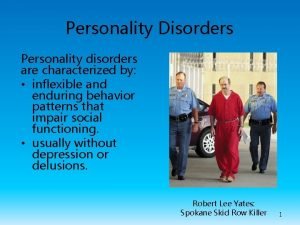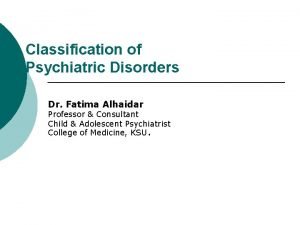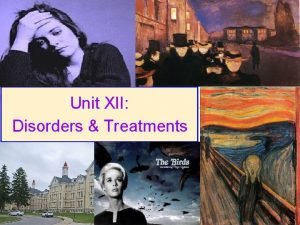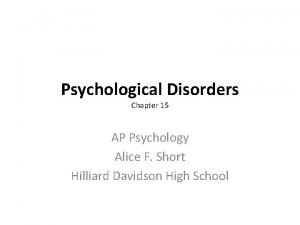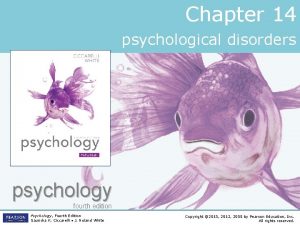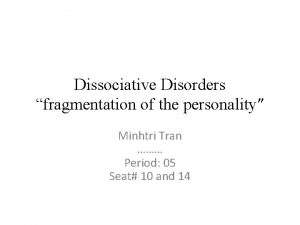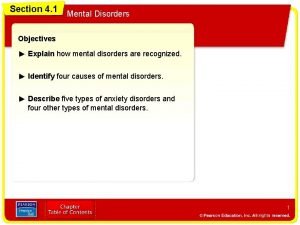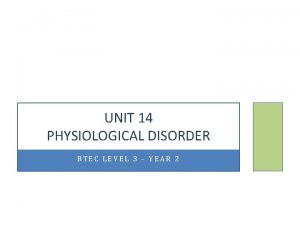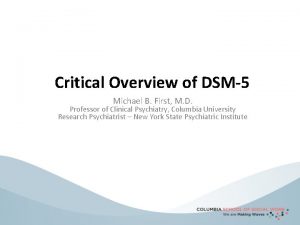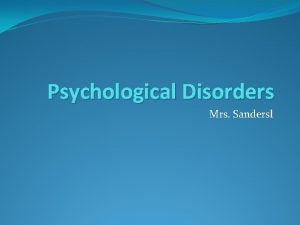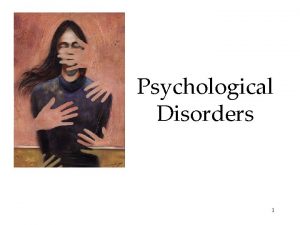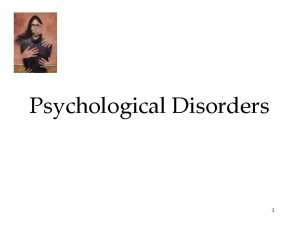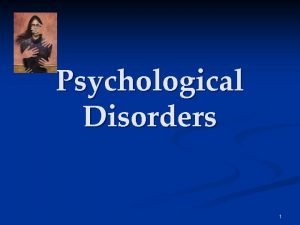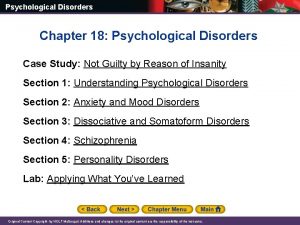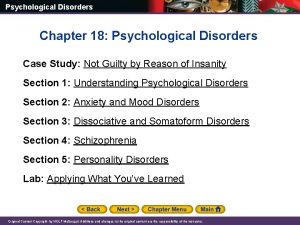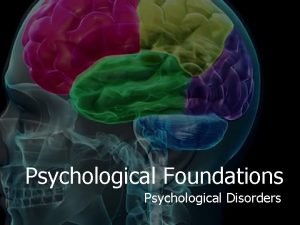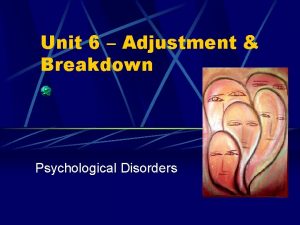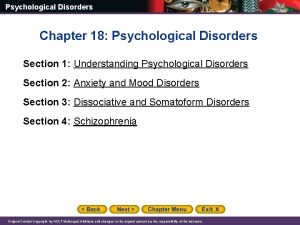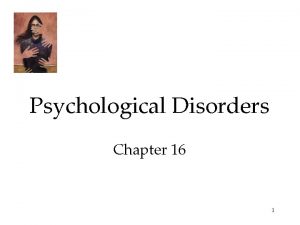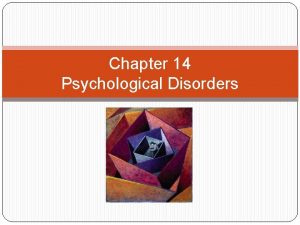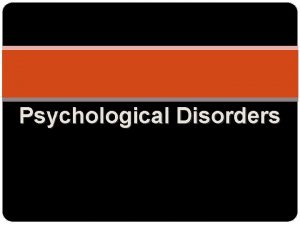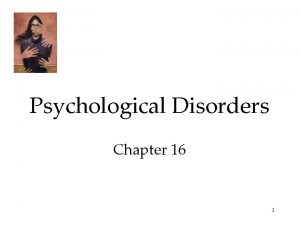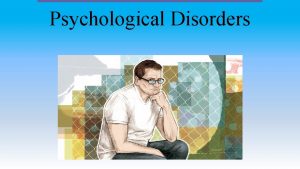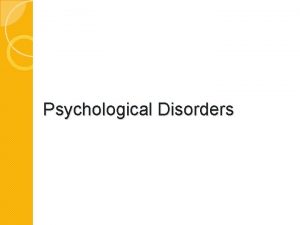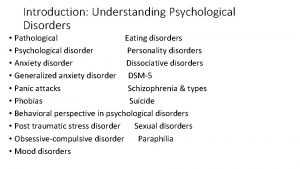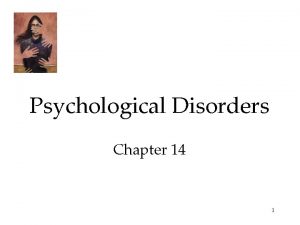Psychological Disorders 1 Psychological Disorders To study the














































![Disorganized & Delusional Thinking This morning when I was at Hillside [Hospital], I was Disorganized & Delusional Thinking This morning when I was at Hillside [Hospital], I was](https://slidetodoc.com/presentation_image/5343c2dfdf5ded8bfac818fdcaec755c/image-47.jpg)


















- Slides: 65

Psychological Disorders 1

Psychological Disorders To study the abnormal is the best way of understanding the normal. William James (1842 -1910) 1. There are 450 million people suffering from psychological disorders (WHO, 2004). 2. Depression and schizophrenia exist in all cultures of the world. 2

Defining Psychological Disorders Mental health workers view psychological disorders as persistently harmful thoughts, feelings, and actions. When behavior is deviant, distressing, and dysfunctional psychiatrists and psychologists label it as disordered (Comer, 2004). 3

Deviant, Distressful & Dysfunctional 1. 3. Carol Beckwith 2. Deviant behavior (going naked) in one culture may be considered normal, while in others it may lead to arrest. Distress must accompany the deviant behavior If a behavior is dysfunctional it is clearly a disorder. In the Wodaabe tribe men wear costumes to attract women. In Western society this would be considered abnormal. 4

Philippe Pinel (1745 -1826) from France, insisted that madness was not due to demonic possession, but an ailment of the mind. George Wesley Bellows, Dancer in a Madhouse, 1907. © 1997 The Art Institute of Chicago Dance in the madhouse. 5

Medical Model When physicians discovered that syphilis led to mental disorders, they started using medical models to review the physical causes of these disorders. 1. 2. 3. 4. Etiology: Cause and development of the disorder. Diagnosis: Identifying (symptoms) and distinguishing one disease from another. Treatment: Treating a disorder in a psychiatric hospital. Prognosis: Forecast about the disorder. 6

Biopsychosocial Perspective Assumes that biological, socio-cultural, and psychological factors combine and interact to produce psychological disorders. 7

Classifying Psychological Disorders The American Psychiatric Association rendered a Diagnostic and Statistical Manual of Mental Disorders (DSM) to describe psychological disorders. The most recent edition, DSM-IV-TR (Text Revision, 2000), describes 400 psychological disorders compared to 60 in the 1950 s. 8

Labeling Psychological Disorders Labels may be helpful for healthcare professionals when communicating with one another and establishing therapy. 9

Labeling Psychological Disorders Critics of the DSM-IV argue that labels may stigmatize individuals. Elizabeth Eckert, Middletown, NY. From L. Gamwell and N. Tomes, Madness in America, 1995. Cornell University Press. Asylum baseball team (labeling) 10

Labeling Psychological Disorders Elaine Thompson/ AP Photo “Insanity” labels raise moral and ethical questions about how society should treat people who have disorders and have committed crimes. Theodore Kaczynski (Unabomber) 11

DSM Multiaxial Classification Axis II Is a Clinical Syndrome (cognitive, anxiety, mood disorders [16 syndromes]) present? Is a Personality Disorder or Mental Retardation present? Is a General Medical Condition (diabetes, Axis III hypertension or arthritis etc) also present? Are Psychosocial or Environmental Problems Axis IV (school or housing issues) also present? What is the Global Assessment of the person’s Axis V functioning? 12

Multiaxial Classification Note 16 syndromes in Axis I 13

Multiaxial Classification Note Global Assessment for Axis V 14

Anxiety Disorders Feelings of excessive apprehension and anxiety. 1. 2. 3. 4. Generalized anxiety disorders Phobias Panic disorders Obsessive-compulsive disorders 15

Generalized Anxiety Disorder Symptoms 1. Persistent and uncontrollable tenseness and apprehension. 2. Autonomic arousal. 3. Inability to identify or avoid the cause of certain feelings. 16

Panic Disorder Symptoms Episodes of intense dread which may include feelings of terror, chest pains, choking, or other frightening sensations. 17

Phobia Marked by a persistent and irrational fear of an object or situation accompanied by avoidance. 18

Kinds of Phobias Agoraphobia Acrophobia Claustrophobia Hemophobia Phobia of open places. Phobia of heights. Phobia of closed spaces. Phobia of blood. 19

Post-Traumatic Stress Disorder Four or more weeks of the following symptoms constitute post-traumatic stress disorder (PTSD): 1. 2. 3. Flashbacks Nightmares Social withdrawal Bettmann/ Corbis 4. Jumpy anxiety 5. Sleep problems 20

Obsessive-Compulsive Disorder Persistence of unwanted thoughts (obsessions) and urges to engage in senseless, ritualistic behavior (compulsions) that cause distress. 21

Brain Imaging A PET scan of the brain of a person with Obsessive-Compulsive Disorder (OCD). High metabolic activity (red) in the frontal lobe areas are involved with directing attention. Brain image of an OCD 22

Explaining Anxiety Disorders Freud suggested that we repress our painful and intolerable ideas, feelings, and thoughts, resulting in anxiety. 23

The Learning Perspective John Coletti/ Stock, Boston Learning theorists suggest that fear conditioning leads to anxiety. This anxiety then becomes associated with other objects or events (stimulus generalization) and is reinforced. 24

The Learning Perspective Investigators believe that fear responses are inculcated through observational learning. Young monkeys develop fear when they watch other monkeys who are afraid of snakes. 25

The Biological Perspective Natural Selection has led our ancestors to learn to fear snakes, spiders, and other animals. Therefore, fear preserves the species. Twin studies suggest that our genes may be partly responsible for developing fears and anxiety. Twins are more likely to share phobias. 26

The Biological Perspective S. Ursu, V. A. Stenger, M. K. Shear, M. R. Jones, & C. S. Carter (2003). Overactive action monitoring in obsessive-compulsive disorder. Psychological Science, 14, 347 -353. Generalized anxiety, panic attacks, and even OCD are linked with brain circuits. Anterior Cingulate Cortex of an OCD patient. 27

Dissociative Disorders Conscious awareness becomes separated (dissociated) from previous memories, thoughts, and feelings. Symptoms 1. 2. 3. Having a sense of being unreal. Being separated from the body. Watching yourself as if in a movie. 28

Dissociative Identity Disorder (DID) Is a disorder in which a person exhibits two or more distinct and alternating personalities, formerly called multiple personality disorder. Lois Bernstein/ Gamma Liason Chris Sizemore (DID) 29

DID Critics argue that the diagnosis of DID increased in the late 20 th century. DID has not been found in other countries. Critics’ Arguments 1. Role-playing by people open to a therapist’s suggestion. 2. Learned response that reinforces reductions in anxiety. 30

Mood Disorders Emotional extremes of mood disorders come in two principal forms. 1. 2. Major depressive disorder Bipolar disorder 31

Major Depressive Disorder Depression is the “common cold” of psychological disorders. In a year, 5. 8% of men and 9. 5% of women report depression worldwide (WHO, 2002). 32

Major Depressive Disorder Major depressive disorder occurs when signs of depression last two weeks or more and are not caused by drugs or medical conditions. Signs include: 1. 2. 3. 4. 5. Lethargy and fatigue Feelings of worthlessness Loss of interest or pleasure Loss of motivation Sleep or appetite disturbance 33

Dysthymic Disorder Dysthymic disorder lies between a blue mood and major depressive disorder. It is a disorder characterized by daily depression lasting two years or more. Blue Mood Dysthymic Disorder Major Depressive Disorder 34

Biological Perspective Genetic Influences: Mood disorders run in families. The rate of depression is higher in identical (50%) than fraternal twins (20%). Jerry Irwin Photography Linkage analysis and association studies link possible genes and dispositions for depression. 35

Neurotransmitters & Depression A reduction of norepinephrine and serotonin has been found in depression. Drugs that alleviate mania reduce norepinephrine. Pre-synaptic Neuron Norepinephrine Serotonin Post-synaptic Neuron 36

The Depressed Brain PET scans show that brain energy consumption rises and falls with manic and depressive episodes. Courtesy of Lewis Baxter an Michael E. Phelps, UCLA School of Medicine 37

Social-Cognitive Perspective The social-cognitive perspective suggests that depression arises partly from self-defeating beliefs and negative explanatory styles. 38

Depression Cycle 1. 2. 3. 4. Negative stressful events. Pessimistic explanatory style. Hopeless depressed state. These hamper the way the individual thinks and acts, fueling personal rejection. 39

Bipolar Disorder Formerly called manic-depressive disorder. An alternation between depression and mania signals bipolar disorder. Depressive Symptoms Manic Symptoms Gloomy Elation/Euphoria Withdrawn Flight of ideas Inability to make decisions Tired Slowness of thought Pressured speech Hyperactive Grandiosity/Irritibility 40

Bipolar Disorder Many great writers, poets, and composers suffered from bipolar disorder. During their manic phase creativity surged, but not during their depressed phase. Hemingway Earl Theissen/ Hulton Getty Pictures Library Clemens The Granger Collection Wolfe George C. Beresford/ Hulton Getty Pictures Library Bettmann/ Corbis Whitman 41

Suicide Each year some 1 million people commit suicide worldwide. 1. 2. 3. 4. 5. Suicide Statistics National differences Racial differences Gender differences Age differences Other differences 42

Risk Factors and Signs history of attempts/gestures n feelings of hopelessness n preoccupation with suicide n recent loss n physical problems n substance use n etc. n 43

Schizophrenia Nearly 1 in a 100 suffer from schizophrenia, and throughout the world over 24 million people suffer from this disease (WHO, 2002). Schizophrenia strikes young people as they mature into adults. It affects men and women equally, but men suffer from it more severely than women. 44

Symptoms of Schizophrenia The literal translation is “split mind, ” which is a misnomer. A group of severe disorders characterized by the following: 1. Disorganized and delusional thinking. 2. Disturbed perceptions. 3. Inappropriate emotions and actions. 45

Disordered thinking loose associations n word salad n clang associations n cognitive flooding/stimulus overload inability to selectively attend n 46
![Disorganized Delusional Thinking This morning when I was at Hillside Hospital I was Disorganized & Delusional Thinking This morning when I was at Hillside [Hospital], I was](https://slidetodoc.com/presentation_image/5343c2dfdf5ded8bfac818fdcaec755c/image-47.jpg)
Disorganized & Delusional Thinking This morning when I was at Hillside [Hospital], I was making a movie. I was surrounded by movie stars … I’m Marry Poppins. Is this room painted blue to get me upset? My grandmother died four weeks after my eighteenth birthday. ” (Sheehan, 1982) Other forms of delusions of This monologue illustratesinclude, fragmented, bizarre persecution (“someone is following me”) or thinking and distorted beliefs called delusions grandeur (“I am a king”). (“I’m Mary Poppins”). 47

Delusions Examples: n Delusions of persecution n Delusions of grandeur n Delusions of reference 48

Disturbed Perceptions A schizophrenic person may perceive things that are not there (hallucinations). Frequently such hallucinations are auditory and lesser visual, somatosensory, olfactory, or gustatory. L. Berthold, Untitled. The Prinzhorn Collection, University of Heidelberg August Natter, Witches Head. The Prinzhorn Collection, University of Heidelberg Photos of paintings by Krannert Museum, University of Illinois at Urbana-Champaign 49

Inappropriate Emotions & Actions A schizophrenic person may laugh at the news of someone dying or show no emotion at all. Patients with schizophrenia may continually rub an arm, rock a chair, or remain motionless for hours (catatonia). 50

Subtypes of Schizophrenia is a cluster of disorders. These subtypes share some features, but there are other symptoms that differentiate these subtypes. 51

Subtypes 52

Chronic and Acute Schizophrenia When schizophrenia is slow to develop (chronic/process) recovery is doubtful. Such schizophrenics usually display negative symptoms. When schizophrenia rapidly develops (acute/reactive) recovery is better. Such schizophrenics usually show positive symptoms. 53

Positive and Negative Symptoms Schizophrenics have inappropriate symptoms (hallucinations, disorganized thinking, deluded ways) that are not present in normal individuals (positive symptoms). Schizophrenics also have (negative symptoms). such as apathy, anhedonia, blunted or flat affect poor social relatedness, etc. 54

Understanding Schizophrenia is a disease of the brain exhibited by the symptoms of the mind. Brain Abnormalities Dopamine Overactivity: Researchers found that schizophrenic patients express higher levels of dopamine D 4 receptors in the brain. 55

Abnormal Brain Activity Brain scans show abnormal activity in the frontal cortex, thalamus, and amygdala of schizophrenic patients. Adolescent schizophrenic patients also have brain lesions. Paul Thompson and Arthur W. Toga, UCLA Laboratory of Neuro Imaging and Judith L. Rapport, National Institute of Mental Health 56

Abnormal Brain Morphology Schizophrenia patients may exhibit morphological changes in the brain like enlargement of fluid-filled ventricles. Both Photos: Courtesy of Daniel R. Weinberger, M. D. , NIH-NIMH/ NSC 57

Genetic Factors The likelihood of an individual suffering from schizophrenia is 50% if their identical twin has the disease (Gottesman, 1991). 0 10 20 30 40 50 Identical Both parents Fraternal One parent Sibling Nephew or niece Unrelated 58

Genetic Factors The following shows the prevalence of schizophrenia in identical twins as seen in different countries. 59

Psychological Factors Psychological and environmental factors can trigger schizophrenia if the individual is genetically predisposed (Nicols & Gottesman, 1983). Courtesy of Genain Family Genain Sisters The genetically identical Genain sisters suffer from schizophrenia. Two more than others, thus there are contributing environmental factors. 60

Personality Disorders Personality disorders are characterized by inflexible and enduring behavior patterns that impair social and occupational functioning. 61

Antisocial Personality Disorder A disorder in which the person (usually men) exhibits a lack of conscience for wrongdoing, even toward friends and family members. Formerly, this person was called a sociopath or psychopath. 62

Understanding Antisocial Personality Disorder PET scans of 41 murderers revealed reduced activity in the frontal lobes. In a follow-up study repeat offenders had 11% less frontal lobe activity compared to normals (Raine et al. , 1999; 2000). Courtesy of Adrian Raine, University of Southern California Normal Murderer 63

Risk and Protective Factors Risk and protective factors for mental disorders (WHO, 2004). 64

Risk and Protective Factors 65
 Psychological disorders characterized by inflexible
Psychological disorders characterized by inflexible Chapter 14 psychological disorders
Chapter 14 psychological disorders Psychiatric disorders
Psychiatric disorders Psychological disorders
Psychological disorders Chapter 18 psychological disorders
Chapter 18 psychological disorders Ap psychology chapter 15
Ap psychology chapter 15 Chapter 18 psychological disorders
Chapter 18 psychological disorders Chapter 14 psychological disorders
Chapter 14 psychological disorders Hát kết hợp bộ gõ cơ thể
Hát kết hợp bộ gõ cơ thể đặc điểm cơ thể của người tối cổ
đặc điểm cơ thể của người tối cổ Cái miệng xinh xinh thế chỉ nói điều hay thôi
Cái miệng xinh xinh thế chỉ nói điều hay thôi Cách giải mật thư tọa độ
Cách giải mật thư tọa độ Tư thế ngồi viết
Tư thế ngồi viết Gấu đi như thế nào
Gấu đi như thế nào Thẻ vin
Thẻ vin Thơ thất ngôn tứ tuyệt đường luật
Thơ thất ngôn tứ tuyệt đường luật Các châu lục và đại dương trên thế giới
Các châu lục và đại dương trên thế giới Từ ngữ thể hiện lòng nhân hậu
Từ ngữ thể hiện lòng nhân hậu Diễn thế sinh thái là
Diễn thế sinh thái là Vẽ hình chiếu vuông góc của vật thể sau
Vẽ hình chiếu vuông góc của vật thể sau V. c c
V. c c Phép trừ bù
Phép trừ bù Lời thề hippocrates
Lời thề hippocrates Hươu thường đẻ mỗi lứa mấy con
Hươu thường đẻ mỗi lứa mấy con đại từ thay thế
đại từ thay thế Chụp tư thế worms-breton
Chụp tư thế worms-breton Quá trình desamine hóa có thể tạo ra
Quá trình desamine hóa có thể tạo ra Công của trọng lực
Công của trọng lực Thế nào là mạng điện lắp đặt kiểu nổi
Thế nào là mạng điện lắp đặt kiểu nổi Các loại đột biến cấu trúc nhiễm sắc thể
Các loại đột biến cấu trúc nhiễm sắc thể Biện pháp chống mỏi cơ
Biện pháp chống mỏi cơ Bổ thể
Bổ thể Vẽ hình chiếu đứng bằng cạnh của vật thể
Vẽ hình chiếu đứng bằng cạnh của vật thể độ dài liên kết
độ dài liên kết Các môn thể thao bắt đầu bằng tiếng bóng
Các môn thể thao bắt đầu bằng tiếng bóng Thiếu nhi thế giới liên hoan
Thiếu nhi thế giới liên hoan Sự nuôi và dạy con của hươu
Sự nuôi và dạy con của hươu Chúa sống lại
Chúa sống lại điện thế nghỉ
điện thế nghỉ Một số thể thơ truyền thống
Một số thể thơ truyền thống Trời xanh đây là của chúng ta thể thơ
Trời xanh đây là của chúng ta thể thơ Số.nguyên tố
Số.nguyên tố Tỉ lệ cơ thể trẻ em
Tỉ lệ cơ thể trẻ em Fecboak
Fecboak Các châu lục và đại dương trên thế giới
Các châu lục và đại dương trên thế giới Thế nào là hệ số cao nhất
Thế nào là hệ số cao nhất ưu thế lai là gì
ưu thế lai là gì Sơ đồ cơ thể người
Sơ đồ cơ thể người Tư thế ngồi viết
Tư thế ngồi viết Retrospective cohort study vs prospective cohort study
Retrospective cohort study vs prospective cohort study Differentiate between time study and motion study
Differentiate between time study and motion study Process of method study
Process of method study Difference between time study and motion study
Difference between time study and motion study Study less study smart
Study less study smart What is case series
What is case series Phytogeographical regions of india map
Phytogeographical regions of india map Derealization vs depersonalization
Derealization vs depersonalization Elsevier
Elsevier Section 4-1 mental disorders answers
Section 4-1 mental disorders answers Nursing management of sleep disorders
Nursing management of sleep disorders Chapter 46 digestive and endocrine disorders
Chapter 46 digestive and endocrine disorders Neuroendocrine syndrome in gynecology
Neuroendocrine syndrome in gynecology Health and social care level 3 unit 14
Health and social care level 3 unit 14 Gender dysphoria dsm 5
Gender dysphoria dsm 5 Bipolar and other related disorders
Bipolar and other related disorders
